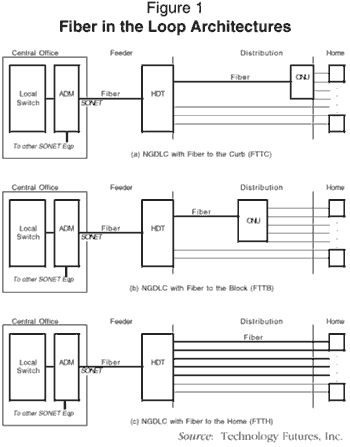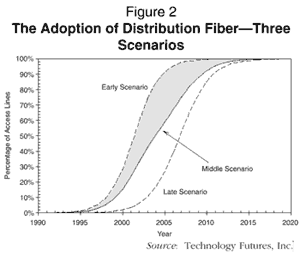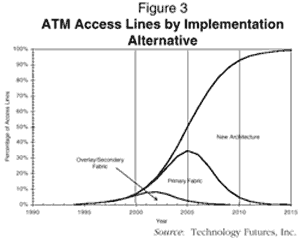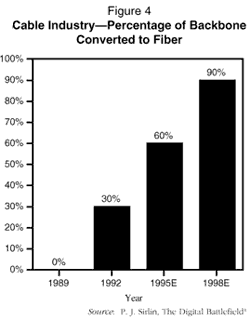
The local exchange carriers (LECs) have over $250 billion invested in their networks. Over 80% of this investment falls into three categories: outside plant, circuit, and switching equipment. In each category, tremendous changes are underway which could render obsolete the bulk of existing investment. In order to wisely manage, maintain, and upgrade this investment, we believe that a review of the forces affecting the telecommunications industry is in order. This article briefly discusses three highly interrelated drivers: technology, competition, and new services. We hope to show how these drivers reinforce each other and how they are changing the competitive environment for local services.
FIBER IN THE LOOP
There are a number of architectures that are under consideration or being planned. A true consensus has yet to emerge on a single FITL architecture. Continuing changes in technology costs, regulation, business relationships, market forecasts, and market share assumptions probably mean that consensus will be arrived at only gradually. Whatever architecture is chosen, it will displace the vast majority of copper investment.
Figure 1 shows some of the FITL alternatives that involve fiber and copper pairs, or fiber alone. Figure 1a shows a Fiber to the Curb (FTTC) architecture, where an Optical Network Unit (ONU) provides service via copper pairs to a small set of homes, generally four, although the number varies from system to system. The ONU is linked back to the Host Digital Terminal (HDT)3 via fiber optics. The figure shows a NGDLC configuration in the feeder and central office, where the HDT provides the interface to the ONU. Not all FITL implementations have to use NGDLC, but it provides a good reference model. Also, for shorter loops (or in some designs), the HDT function can be moved to the central office with a single fiber link connecting the central office and the ONU. The advantages of FTTC include its ability to deliver high data rates over a very short copper drop. Its disadvantages include the need to power and maintain a large number of widely-dispersed active network elements, the need to place new fiber throughout neighborhoods, and minimal sharing of the optoelectronics in the ONU.

Figure 1b shows an alternative that maintains some of the advantages of FTTC and partially avoids some of the disadvantages. Called Fiber to the Block (FTTB), it places the ONU closer to the HDT. More customers, as many as several dozen, share the costs of the ONU, and less new fiber needs to be buried. Also fewer active network elements are involved. On the other hand, it cannot provide as high a data rate to each customer as can FTTC, and more of the disadvantages of copper remain in the network.
A third alternative, called Fiber to the Home (FTTH), is shown in Figure 1c. With this option, the ONU function resides in the home instead of the network. (Of course, FTTH has its equivalent in Fiber to the Office or Fiber to the Apartment Building.) FTTH has lost favor in North America, but is still a target in other countries such as Japan. Its disadvantages include:
Its advantages include essentially infinite, two-way, dedicated bandwidth to every home, the complete absence of any of the problems of copper, and a much smaller requirement for active network elements.
Our analysis of distribution facilities includes three scenarios for the adoption of FITL which are shown in Figure 2. Each of these scenarios is based on composite forecasts of the demand for wideband and broadband services. The "early" scenario assumes that fiber is deployed rapidly to meet the emerging demand for new wideband services at 1.5 Mb/s or similar data rates. The "late" scenario assumes wideband services are deployed on copper pairs using improved T-1 technologies such as ADSL and HDSL, and the fiber is not rapidly adopted until demand for broadband services (45 Mb/s and above) emerges. The "middle" scenario is an average of the two others.

SYNCHRONOUS OPTICAL NETWORK (SONET)
SONET is a new format for organizing information on a fiber optics channel that recognizes the need for integrating different types of traffic on the same pair of fibers. Among its many advantages are standardized optical and electrical interfaces to which all suppliers must adhere. Another is that an individual information stream on a fiber channel can be efficiently separated from the rest of the information on the channel. With a SONET add-drop multiplexer, any signal can be extracted with a single piece of equipment without breaking down the whole signal. SONET add-drop multiplexers are already cost-competitive with asynchronous equipment, and soon will be commodity items that are integrated into almost every piece of circuit (and switching) equipment. This will render much of the existing circuit equipment redundant, including digital crossconnects and multiplexers.
Further, with SONET, carriers can mix-and-match circuit equipment so that they can use different manufacturers' equipment. This, of course, provides operational and equipment savings, as well as more competition among manufacturers. Later, SONET interfaces will be built directly into switches, leading to even more equipment savings. NGDLC systems will directly link to switches through SONET interfaces. From the same unit, some channels may be connected to other switches or facilities using a built-in SONET add-drop multiplexer. Circuits could be transferred from one switch to another instantaneously. This will give carriers much more flexibility when it comes to dealing with switch manufacturers. SONET will benefit customers as well as carriers. In addition to the inherent economic benefits of a more efficient network, SONET will provide greater reliability through its support of fiber ring architecture and enhanced response time and flexibility in provisioning new channels.
Our industry average for SONET adoption implies that, before 2005, essentially all currently-deployed digital circuit equipment will have been replaced by SONET equipment.
ADVANCED DIGITAL SWITCHING
The next major switching generation -- ATM switching -- is optimized to handle all types of traffic on the network efficiently and quickly. Today's digital switches use time division multiplexing to connect continuous streams of digitized voice or data at 64 Kb/s for the duration of a call. This is efficient for low-speed, circuit-switched applications such as voice, but it is unusable or inefficient for high-speed digital applications, especially those with bursty (non-continuous) traffic characteristics. ATM switches, on the other hand, use small fixed-length packets called cells. Unlike conventional packet switches, ATM switches do not introduce significant signal delay (because of the simple cell structure), which means they can be used for continuous, real-time applications such as voice or videoconferencing. However, since ATM uses packet switching, it is also good for bursty data traffic. The ability to handle all types of traffic, at all variable data rates, not only makes ATM an efficient switch, but it is also ideal for networked multimedia applications that use all types of communications.
This ability to handle all types of traffic will greatly simplify the network. Currently, the network is an aggregation of special purpose and general purpose networks. In the future, with the implementation of ATM, the network will evolve into a general purpose network capable of meeting all communication demands. ATM is currently being implemented as an overlay network. In the near future, it will be available as a secondary fabric on existing digital switches, followed by becoming the primary fabric, and eventually as a new architecture. Our forecasts for these implementation alternatives are shown in Figure 3.

HIGH-CAPACITY DIGITAL WIRELESS
The capacity constraints that are reflected in high cellular prices will soon evaporate. Technology and the Federal Communications Commission (FCC) are contributing to what soon may become an overabundance of capacity. TDMA technology, already being adopted, increases the capacity of existing systems by a factor of three. Under testing are CDMA technologies that will increase capacity by a factor of 10 to 20. Advanced antenna technologies can further multiply the capacity of any of these alternatives many times. By allocating 120 MHz of additional spectrum to PCS licensees, the FCC effectively tripled the bandwidth available to wireless carriers. Thus, in a matter of a few years, capacity will be sufficient to satisfy any conceivable growth pattern in either number of subscribers or usage. One implication of the increased capacity is the ability to compete directly with wireline service.
In summary, the benefits of these technologies are reduced operating costs, reduced capital costs, better service, or, in some cases, new services. The technologies are all well-understood and do not require scientific, engineering, or economic breakthroughs to be deployed. There is widespread agreement about their benefits and cost targets. While there is some controversy about the details and timing, there is consensus that the future of telecommunications is built around these technologies.
The next competitive arena will be the mass market for voice services. Such competition has already begun in public phones, and, in some states, in intra-LATA long distance. Two additional, more pervasive sources of competition are cable television networks and wireless networks, specifically cellular and personal communications services (PCS). Technologies are emerging that will allow voice to be added to state-of-the-art cable systems at a cost that is less than on copper pairs. Figure 4 shows the rate at which cable companies are upgrading their backbone routes to fiber, which will enable them to cost effectively offer telephony and other services. On a per-subscriber basis, cellular technologies are already less costly than wireline. With the new high-capacity digital wireless technologies, such as TDMA and especially CDMA, wireless technologies will also be less costly on a per-minute-of-use basis. We estimate that, by 1999, the number of wireless users will grow to at least 40 million and perhaps to as many as 80 million.

Because they are more efficient, the new technologies offer very substantial cost advantages to new entrants in local telecommunications. These new entrants can invest in the most efficient modern equipment without regard to an embedded infrastructure such as the LECs have. This, in turn, will pressure LECs to adopt new technology quickly in order to stay competitive. Thus, competition reinforces the technology drivers and magnifies the obsolescence of the old technology.
Ultimately, the telephone network will provide full broadband, multimedia communications services based on three of the technologies we have mentioned: fiber optics, SONET transmission, and ATM switching. Along the way, intermediate steps will include narrowband ISDN and video on demand services. Since some of the new services blur the traditional distinctions between telephony, television, publishing, information systems, and computing, they foster a new type of competition focused on the convergence of these industries. In this environment, competitive advantages belong to those companies that can deliver a package of diverse services for the least cost. As it happens, the new technologies allow delivery of multiple services at overall costs that are comparable or less than the traditional delivery mechanisms for individual services.